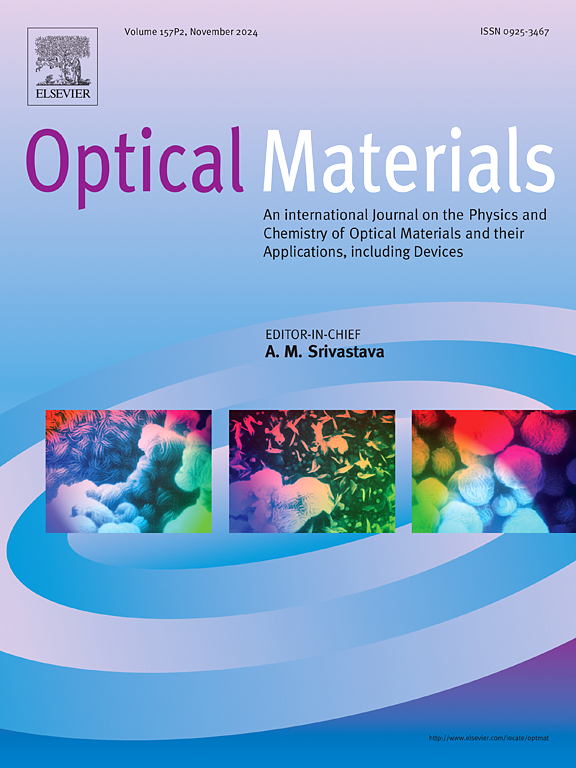Transient response of low-temperature ALD-grown ZnO thin film-based p–i–n UV photodetector
IF 4.2
3区 材料科学
Q2 MATERIALS SCIENCE, MULTIDISCIPLINARY
引用次数: 0
Abstract
This work presents an ultraviolet (UV) photodetector based on zinc oxide (ZnO) thin films grown via atomic layer deposition (ALD) technique on silica (SiO2–Si) substrates in a p–i–n configuration (p-Si/i-SiO2/n-ZnO). The ZnO films, deposited at 120 °C, exhibit a nanocrystalline structure with a dominant (110) orientation and a direct bandgap of 3.07 eV, indicating their suitability for UVA sensing (315–400 nm). The device exhibits a low dark current, high UV sensitivity, and stable, repeatable ON/OFF switching under 365 nm illumination at 0.05 mW cm−2 at room temperature. I–V characteristics indicate efficient photocarrier transport. The dynamic response of the photodetector was measured at various bias voltages ranging from 0 V to 18 V. The sensitivity of the device was highest (1.17) at 0 V. At the same time, other parameters like responsivity (3.82 × 102 A W−1), detectivity (7.14 × 1012 Jones), external quantum efficiency (EQE) (1.3 × 103 %) were found to be maximum at 18 V meanwhile the rise (0.3 s) and decay time (0.2 s) was minimum at this bias. These results demonstrate the potential of ALD–ZnO thin films for high-performance, room-temperature UV photodetectors, making them suitable for future integrated and wearable optoelectronics.

低温ald生长ZnO薄膜型p-i-n紫外探测器的瞬态响应
本研究提出了一种基于氧化锌(ZnO)薄膜的紫外(UV)光电探测器,该薄膜是通过原子层沉积(ALD)技术在二氧化硅(SiO2-Si)衬底上以p-i-n结构(p-Si/i-SiO2/n-ZnO)生长的。在120°C下沉积的ZnO薄膜呈现出优势取向(110)和直接带隙3.07 eV的纳米晶结构,表明其适合UVA传感(315-400 nm)。该器件具有低暗电流,高紫外灵敏度,在室温下,在0.05 mW cm−2的365 nm照明下稳定,可重复的开/关开关。I-V特性表明有效的光载流子输运。测量了光电探测器在0 ~ 18 V不同偏置电压下的动态响应。器件在0 V时灵敏度最高(1.17)。同时,其他参数如响应度(3.82 × 102 A W−1)、探测率(7.14 × 1012 Jones)、外量子效率(EQE) (1.3 × 103%)在18 V时最大,上升时间(0.3 s)和衰减时间(0.2 s)最小。这些结果证明了ALD-ZnO薄膜作为高性能室温紫外光电探测器的潜力,使其适用于未来的集成和可穿戴光电子产品。
本文章由计算机程序翻译,如有差异,请以英文原文为准。
求助全文
约1分钟内获得全文
求助全文
来源期刊

Optical Materials
工程技术-材料科学:综合
CiteScore
6.60
自引率
12.80%
发文量
1265
审稿时长
38 days
期刊介绍:
Optical Materials has an open access mirror journal Optical Materials: X, sharing the same aims and scope, editorial team, submission system and rigorous peer review.
The purpose of Optical Materials is to provide a means of communication and technology transfer between researchers who are interested in materials for potential device applications. The journal publishes original papers and review articles on the design, synthesis, characterisation and applications of optical materials.
OPTICAL MATERIALS focuses on:
• Optical Properties of Material Systems;
• The Materials Aspects of Optical Phenomena;
• The Materials Aspects of Devices and Applications.
Authors can submit separate research elements describing their data to Data in Brief and methods to Methods X.
 求助内容:
求助内容: 应助结果提醒方式:
应助结果提醒方式:


